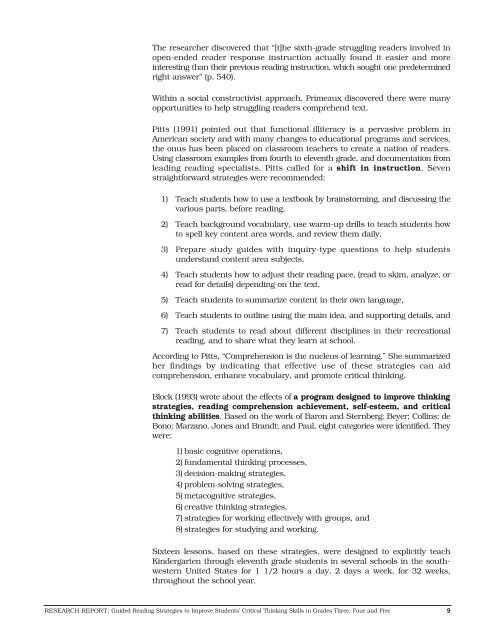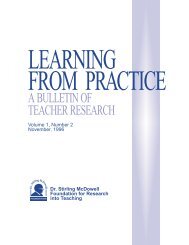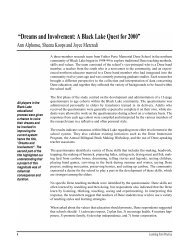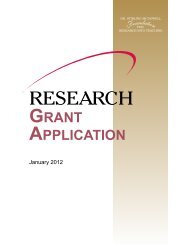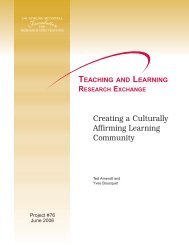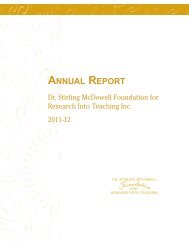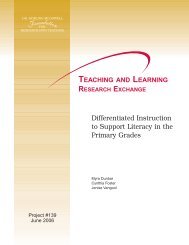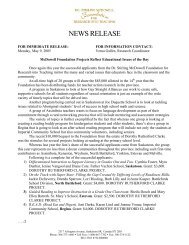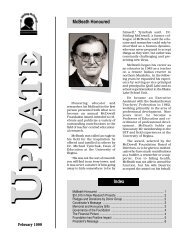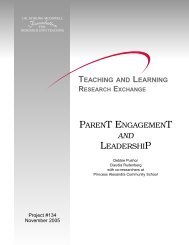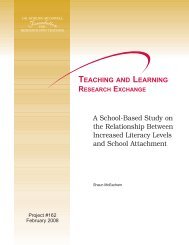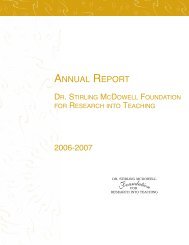Guided Reading Strategies to Improve Students - Dr. Stirling ...
Guided Reading Strategies to Improve Students - Dr. Stirling ...
Guided Reading Strategies to Improve Students - Dr. Stirling ...
- No tags were found...
You also want an ePaper? Increase the reach of your titles
YUMPU automatically turns print PDFs into web optimized ePapers that Google loves.
The researcher discovered that “[t]he sixth-grade struggling readers involved inopen-ended reader response instruction actually found it easier and moreinteresting than their previous reading instruction, which sought one predeterminedright answer” (p. 540).Within a social constructivist approach, Primeaux discovered there were manyopportunities <strong>to</strong> help struggling readers comprehend text.Pitts (1991) pointed out that functional illiteracy is a pervasive problem inAmerican society and with many changes <strong>to</strong> educational programs and services,the onus has been placed on classroom teachers <strong>to</strong> create a nation of readers.Using classroom examples from fourth <strong>to</strong> eleventh grade, and documentation fromleading reading specialists, Pitts called for a shift in instruction. Sevenstraightforward strategies were recommended:1) Teach students how <strong>to</strong> use a textbook by brains<strong>to</strong>rming, and discussing thevarious parts, before reading,2) Teach background vocabulary, use warm-up drills <strong>to</strong> teach students how<strong>to</strong> spell key content area words, and review them daily,3) Prepare study guides with inquiry-type questions <strong>to</strong> help studentsunderstand content area subjects,4) Teach students how <strong>to</strong> adjust their reading pace, (read <strong>to</strong> skim, analyze, orread for details) depending on the text,5) Teach students <strong>to</strong> summarize content in their own language,6) Teach students <strong>to</strong> outline using the main idea, and supporting details, and7) Teach students <strong>to</strong> read about different disciplines in their recreationalreading, and <strong>to</strong> share what they learn at school.According <strong>to</strong> Pitts, “Comprehension is the nucleus of learning.” She summarizedher findings by indicating that effective use of these strategies can aidcomprehension, enhance vocabulary, and promote critical thinking.Block (1993) wrote about the effects of a program designed <strong>to</strong> improve thinkingstrategies, reading comprehension achievement, self-esteem, and criticalthinking abilities. Based on the work of Baron and Sternberg; Beyer; Collins; deBono; Marzano, Jones and Brandt; and Paul, eight categories were identified. Theywere:1) basic cognitive operations,2) fundamental thinking processes,3) decision-making strategies,4) problem-solving strategies,5) metacognitive strategies,6) creative thinking strategies,7) strategies for working effectively with groups, and8) strategies for studying and working.Sixteen lessons, based on these strategies, were designed <strong>to</strong> explicitly teachKindergarten through eleventh grade students in several schools in the southwesternUnited States for 1 1/2 hours a day, 2 days a week, for 32 weeks,throughout the school year.RESEARCH REPORT: <strong>Guided</strong> <strong>Reading</strong> <strong>Strategies</strong> <strong>to</strong> <strong>Improve</strong> <strong>Students</strong>’ Critical Thinking Skills in Grades Three, Four and Five9


